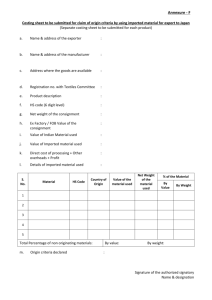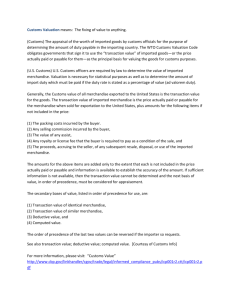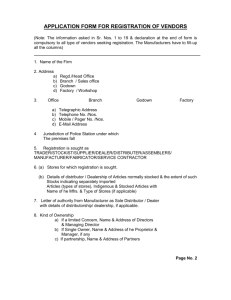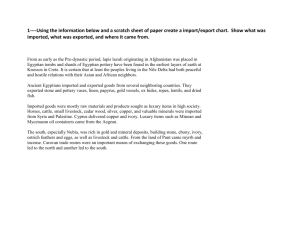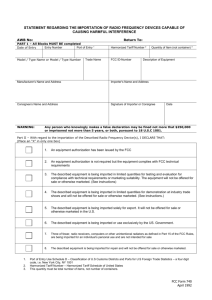The East African Community Customs Union
advertisement
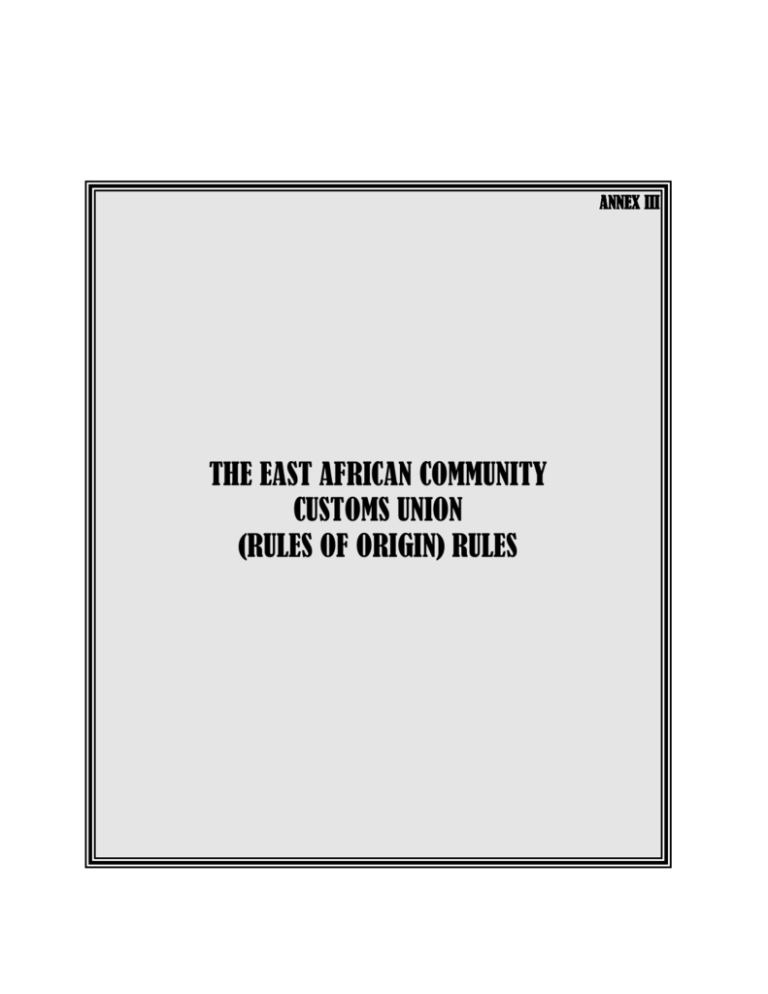
ANNEX III THE EAST AFRICAN COMMUNITY CUSTOMS UNION (RULES OF ORIGIN) RULES THE EAST AFRICAN COMMUNITY CUSTOMS UNION (RULES OF ORIGIN) RULES TABLE OF CONTENTS RULE TITLE 1 2 3 4 5 6 Citation Purpose of the Rules of Origin Interpretation Origin Criteria Goods Wholly Produced in a Partner State Application of Percentage of Imported Materials and Value Added Criteria Process Not Conferring Origin Unit of qualification Separation of Materials Treatment of Mixtures Treatment of Packing Documentary Evidence Infringement and Penalties Manuals Directives by the Council Cessation of the Rules of Origin 7 8 9 10 11 12 13 14 15 16 SCHEDULES i THE EAST AFRICAN COMMUNITY CUSTOMS UNION (RULES OF ORIGIN) RULES RULE 1 Citation These Rules may be cited as the East African Community Customs Union (Rules of Origin) Rules (hereinafter referred to as the "Rules "). RULE 2 Purpose of the Rules of Origin The purpose of these Rules is to implement the provisions of Article 14 of the Protocol and to ensure that there is uniformity among Partner States in the application of the Rules of Origin and that to the extent possible the process is transparent, accountable, fair, predictable and consistent with the provisions of the Protocol. RULE 3 Interpretation In these Rules, unless where the context otherwise requires: "change in tariff heading criteria" means the criteria according to which substantial transformation is deemed to have occurred when all the materials used in the production of a product are classified in a heading other than that of the product; "classified" means the classification of a product of material under a particular heading in the Harmonised Commodity Description and Coding System; 1 "Committee" means the East African Community Committee on Trade Remedies established under Article 24 of the Protocol on the Establishment of the East African Community Customs Union; "competent authority" means a body or organization designated by a Partner State to issue East African Community Certificates of Origin; "Council" means the Council of Ministers of the Community established by Article 9 of the Treaty; "customs value" means the value as determined in accordance with the Agreement on Implementation of Article VII of the General Agreement on Tariffs and Trade, 1994 (WTO Agreement on Customs Valuation); "ex-factory cost" means the value of the total inputs required to produce a given product; "goods" means both materials and products; "heading" means four digit codes used in the Harmonised Commodity Description and Coding System; "manufacturing" means any kind of working or processing, including assembly or specific operations; "materials" means raw materials, semi-finished products, products, ingredients, parts and components used in the production of goods; "Partner States" means the Republic of Uganda, the Republic of Kenya and the United Republic of Tanzania and any other country granted membership to the Community under Article 3 of the Treaty; "produced" and "a process of production" include the application of any operation or processes with the exception of any operation or processes as set out in Rule 7 of these Rules; 2 "producer" includes a mining, manufacturing or agricultural enterprise or any individual grower or craftsman who supplies goods for export; "product" means a manufactured product and includes a product intended for later use in another manufacturing operation; "Secretariat " means the Secretariat of the Community established by Article 9 of the Treaty; "substantial transformation criteria" means the criteria according to which origin is determined by regarding as the country of origin, the country in which the last substantial manufacturing or processing, deemed sufficient to give the commodity its essential character is carried out"; "Summit" means the Summit established by Article 9 of the Treaty; "Treaty" means the Treaty for the Establishment of the East African Community; "value added" means the ex-factory cost of a finished product minus the customs value of the materials imported from outside the Partner States and used in the process of production; "vessel of a Partner State" means a vessel of a Partner State which is registered in a Partner State and satisfies one of the following conditions: (a) at least 75 per centum of the officers of the vessel are nationals of the Partner State; (b) at least 75 per centum of the crew of the vessel are nationals of the Partner State; or (c) at least the majority control and equity holding in respect of the vessel are held by nationals of the Partner State or institution, 3 agency, enterprise or corporation of the Government of that Partner State. RULE 4 Origin Criteria 1. 2. Goods shall be accepted as originating in a Partner State where they are consigned directly from a Partner State to a consignee in another Partner State and where: (a) they have been wholly produced as provided for in Rule 5 of these Rules; or (b) they have been produced in a Partner State wholly or partially from materials imported from outside the Partner State or of undetermined origin by a process of production which effects a substantial transformation of those materials such that: (i) the c.i.f. value of those materials does not exceed sixty per centum of the total cost of the materials used in the production of the goods; (ii) the value added resulting from the process of production accounts for at least thirty five per centum of the exfactory cost of the goods as specified in the First Schedule to these Rules; and (iii) the goods are classified or become classifiable under a tariff heading other than the tariff heading under which they were imported as specified in the Second Schedule to these Rules. The following are the principles of cumulative treatment: 4 3. (a) for purposes of implementing these Rules, the Partner States shall be considered as one territory; and (b) raw materials or semi-finished goods originating in any of the Partner States and undergoing working or processing either in one or more Partner State shall, for the purpose of determining the origin of the finished product be deemed to have originated in the Partner State where the final processing or manufacturing takes place. In determining: (a) the place of production of marine, river or lake products and goods in relation to a Partner State, a vessel of a Partner State shall be regarded as part of the territory of that Partner State; and (b) the place from which goods originated, marine, river or lake products taken from the sea, river or lake or goods produced from the sea, river or lake shall be regarded as having their origin in the territory of a Partner State where they were taken by a vessel or produced in a vessel of that Partner State and are brought directly to the territory of the Partner States. RULE 5 Goods Wholly Produced in a Partner State 1. For purposes of Rule 4(1) (a) of these Rules, the following are among the products, which shall be regarded as wholly produced in a Partner State: (a) mineral products extracted from the ground or sea-bed of the Partner State; 5 (b) vegetable products harvested within the Partner State; (c) live animals born and raised within the Partner State; (d) products obtained from live animals within the Partner State; (e) products obtained by hunting or fishing conducted within the Partner State; (f) products obtained from the sea, rivers or lakes within the Partner States by a vessels of that Partner State; (g) products manufactured in a factory of a Partner State exclusively from the products referred to in sub-paragraph (f); used articles fit only for the recovery of materials, provided that such articles have been collected from users within the Partner States; (h) 2. (i) scrap and waste resulting from manufacturing operations within the Partner State; and (j) goods produced within the Partner State exclusively or mainly from the following: (i) products referred to in sub-paragraphs (a) to (i); and (ii) materials containing no elements imported from outside the Partner State or which are of indetermined origin. Electrical power, fuel, plant, machinery and tools used in the production of goods shall always be regarded as wholly produced within the Partner States when determining the origin of the goods. 6 RULE 6 Application of Percentage of Imported Materials and Value Added Criteria For purposes of Rule 4(1) (b) and (c) of these Rules: (a) any materials which meet the condition specified in Rule 4(1) (a) of these Rules shall be regarded as containing no elements imported from outside the Partner States; (b) the value of any materials which can be identified as having been imported from outside the Partner States shall be their c.i.f. value accepted by the customs authorities on clearance for home consumption, or on temporary admission at the time of last importation into the Partner State where they were used in a process of production, less the amount of any transport costs incurred in transit through other Partner States; (c) where the value of any materials imported from outside the Partner States cannot be determined in accordance with paragraph (b) of this Rule, their value shall be the earliest ascertainable price paid for them in the Partner State where they were used in a process of production; and (d) where the origin of any material cannot be determined, the material shall be deemed to have been imported from outside the Partner States and its value shall be the earliest ascertainable price paid for the material in the Partner State where the material is used in a process of production. RULE 7 Processes not Conferring Origin 7 Notwithstanding the provisions of Rule 4(1) (b) and (c) of these Rules, the following operations and processes shall be considered as insufficient to support a claim that goods originate from a Partner State: (a) (b) packaging, bottling, placing in flasks, bags, cases and boxes, fixing on cards or boards and all other simple packaging operations; (i) simple mixing of ingredients imported from outside a Partner State; (ii) simple assembly of components and parts imported from outside a Partner State to constitute a complete product; and (iii) simple mixing and assembly where the costs of the ingredients, parts and components imported from outside a Partner State used in any processes exceed sixty per centum of the total costs of the ingredients, parts and components used; (c) operations to ensure the preservation of merchandise in good condition during transportation and storage such as ventilating, spreading out, drying, freezing, placing in brine, sulphur dioxide or other aqueous solutions, removal of damaged parts and similar operations; (d) changes of packing and breaking up or assembly of consignments; (e) marking, labeling or affixing other like distinguishing signs on products or their packages; 8 (f) simple operations consisting of removal of dust, sifting or screening, sorting, classifying and matching, including the making up of sets of goods, washing, painting and cutting up; (g) a combination of two or more operations referred to in subparagraphs (a) to (f) of this Rule; and (h) slaughter of animals. RULE 8 Unit of Qualification 1. In classifying goods under this Rule, each item in a consignment shall be considered separately. 2. Notwithstanding the provisions of paragraph 1 of this Rule: (a) where the Harmonised Commodity Description and Coding System specifies that a group, set or assembly of articles is to be classified within a single heading, such a group, set or assembly shall be treated as one article; (b) tools, parts and accessories imported with an article, and whose prices are included in the price of tools, parts and accessories which are imported with the article or for which no separate charge is made, shall be considered as forming a whole with the article which the tools, parts and accessories constitute the standard equipment customarily included in the sale of articles of that kind; and (c) in cases not within the provisions of sub-paragraphs (a) and (b) of this paragraph, goods shall be treated as a single article where they are so treated for purposes of assessing customs duties on like articles by the importing Partner States. 9 3. An unassembled or dissembled article, which is imported in more than one consignment because it is not feasible for transportation or production reasons to import it in a single consignment, shall be treated as one article. RULE 9 Separation of Materials 1. For products or industries where it is not practicable for the producer to physically separate materials of similar character but different origin used in the production of goods, such separation may be replaced by an appropriate accounting system which ensures that no more goods are deemed to originate in the Partner States than would have been the case where the producer had been able to physically separate the materials. 2. Any accounting system referred to in paragraph 1 shall conform to the conditions that may be agreed upon by the Council in order to ensure that adequate control measures are applied. RULE 10 Treatment of Mixtures 1. In the case of mixtures, which are not being groups, sets or assemblies of goods dealt with under Rule 8 of these Rule, a Partner State may refuse to accept as originating in a Partner State, any product resulting from the mixing together of goods which would qualify as originating in the Partner State with goods which would not qualify as originating in that Partner State, 10 where the characteristics of the product as a whole are not different from the characteristics of the goods which have been mixed. 2. In the case of particular products where it is recognized by the Council that it is desirable to permit mixing together of goods described in paragraph 1 of this Rule, such products shall be accepted as originating in the Partner States in respect of that part of the product as may be shown to correspond to the quantity of goods originating in the Partner States used in the mixing, subject to such conditions as may be agreed upon by the Council. RULE 11 Treatment of Packing 1. For purposes of assessing customs duties, a Partner State may treat goods separately from their packing and may in respect of its imports consigned from another Partner State, determine separately the origin of such packing. 2. Where paragraph 1 of this Rule is not applicable, packing shall be considered as forming a whole with the goods and no part of any packing required for their transport or storage shall be considered as having been imported from outside the Partner States in determining the origin of the goods as a whole. 3. For purposes of paragraph 2 of this Rule, packing with which goods are ordinarily sold at retail shall not be regarded as packing required for the transport or storage of the goods. 4. Containers which are used purely for transportation and temporary storage of goods and are to be returned shall not be subject to customs duties and other charges of equivalent effect. 5. Containers used for transportation and temporary storage of goods, which are not returned, shall be treated separately from the goods contained in 11 them and shall be subject to import duties and other charges of equivalent effect. RULE 12 Documentary Evidence 1. The claim that goods originate from a Partner State, shall be supported by an East African Community Certificate of Origin by the exporter or exporter's representative in the form prescribed in the Third Schedule to these Rules, and shall be authenticated by a competent authority. 2. A producer, who is not an exporter, shall in respect of goods intended for export, furnish the exporter with a written declaration in conformity with the Fourth Schedule to these Rules, showing that the goods originate in a `Partner State under the provisions of Rule 4 of these Rules. 3. The competent authority may in exceptional circumstances and notwithstanding the presentation of an East African Community Certificate of Origin issued in accordance with the provisions of this Rule, require, further verification of the statement contained in that Certificate. 4. Where a request for further verification is made, by a competent authority under this Rule, the verification shall be made within three months of the request using the form specified in the Fifth Schedule to these Rules. 5. The importing Partner State shall not prevent the importer from taking delivery of goods solely on the grounds that it requires further evidence, but may require security for any duty or other charge which may be payable. 6. Where the goods are subject to any prohibitions, the stipulations for delivery under security shall not apply. 7. Copies of the East African Community Certificates of Origin and other relevant documentary evidence shall be preserved by the competent 12 authorities of the Partner State for at least five years from the date of issuance. 8. Each Partner State shall deposit with the Secretariat the names of the competent authorities, the specimen signatures of officials authorized to sign the certificates and the impressions of the official stamps to be used for that purpose, and the names, signatures and impressions shall be circulated to the other Partner States by the Secretariat. RULE 13 Infringement and Penalties 1. A Partner State which does not have national legislation on rules of origin, undertakes to enact such legislation to make provision for penalties against persons who furnish or cause to be furnished false documents in support of claims conferring origin of goods in other Partner States that the goods be accepted as originating from that Partner State. 2. A Partner State to which a false claim is made in respect of the origin of goods shall immediately bring the matter to the attention of the exporting Partner State from which the false claim is made, for appropriate action. 3. A Partner State which has, in pursuance of the provisions of paragraph 2 of this Rule, brought to the attention of an exporting Partner State a false claim may, where the Partner State is of the opinion that no satisfactory action has been taken within a reasonable time by the exporting Partner State, refer the matter to the Committee. 4. Where a matter is referred to the Committee, the Committee shall take appropriate measures in accordance with the relevant provisions of the Treaty. 13 5. Any continued infringement by a Partner State of the provisions of these Rules may be referred to the Council which shall take measures in accordance with the provisions of the Treaty. RULE 14 Manuals The Secretariat shall develop and review manuals in respect of these Rules. RULE 15 Directives by the Council The Council may issue directives for the better carrying out of the provisions of these Rules in accordance with Article 14 of the Treaty. RULE 16 Cessation of the Rules of Origin The Summit shall, upon recommendation from the Council verifying that the objectives of the Customs Union have been fully achieved, declare the cessation of these Rules. 14 FIRST SCHEDULE Rule 4 (1) (b) (ii) ELEMENTS OF EX-FACTORY COST 1. In the calculation of the ex-factory cost determining value added in terms of Rule 4(1) (b) (ii), the following elements of costs, charges and expenses shall be included: (a) the cost of imported materials, including the cost of waste materials and materials lost in the process of manufacture, as represented by landed costs of these materials at the factory, including any charges incidental to the delivery of such materials to the factory but excluding customs duties and other duties and charges of equivalent effect on the cost of the imported materials: Provided that the cost of imported materials not imported by the manufacturer will be the delivery cost at the factory but excluding customs duties and other duties and charges of equivalent effect on the cost of the imported materials; 15 (b) the cost of local materials, including the cost of waste materials and materials lost in the process of manufacture, as represented by their delivery price at the factory; (c) the cost of direct labour as represented by the wages paid to the operatives responsible for the manufacture of the goods; (d) the cost of direct factory expenses are represented by: (e) (i) the operating cost of the machine being used to manufacture the goods; (ii) the expenses incurred in the cleaning, drying, polishing, pressing or any other process, as may be necessary for the finishing of the goods; (iii) the cost of putting the goods up in their retail packages and the cost of such retail packages but excluding any extra cost of packing the goods for transportation or export and the cost of any extra packages; (iv) the cost of special designs, drawings or lay out; and (v) the hire of tools, or equipment for the production of goods; and the cost of factory overheads as represented by: (i) rent, rates and insurance charges directly attributed to the factory; (ii) indirect labour charges, including salaries paid to factory managers, wages paid to foremen, examiners and testers of the goods; (iii) power, light, water and other service charges directly attributed to the cost of manufacture of the goods; (iv) consumable stores, including minor tools, grease, oil and other incidental items and materials used in the manufacture of the goods; and (v) depreciation and maintenance of factory buildings, plant machinery, tools and other items used in the manufacture of the goods; and others. 16 2. In the calculation of the ex-factory cost determining value added in terms of Rule 4(1) (b) (ii), the following elements of costs, charges and expenses are excluded: (a) (b) (c) (d) administration expenses represented by : (i) office expenses, office rent and salaries paid to accountants, clerks, manager and other executive personnel; (ii) directors’ fees other than salaries paid to directors who act in the capacity of factory managers; (iii) statistical and costing expenses in respect of manufactured goods; and (iv) investigation and experimental expenses; selling expenses represented by: (i) the cost of soliciting and securing of orders, including expenses such as advertising charges and agents’ or salespersons’ commissions or salaries; and (ii) expenses incurred in the making of designs, estimates and tenders; distribution expenses, represented by all the expenditure incurred after the goods have left the factory, including: (i) the cost of any materials and payments of wages incurred in the packaging of the goods for export; (ii) warehousing expenses incurred in the storage of the finished goods; and (iii) the cost of transporting the goods to their destination; charges not directly attributed to the manufacture of the goods represented by: (i) any customs duty and other duties and charges of equivalent effect paid on the imported raw materials; (ii) any excise duty paid on raw materials produced in the country where the finished goods are manufactured; 17 (iii) any other indirect taxes paid on the manufactured products; (iv) any royalties paid in respect of patents, special machinery or designs; and (v) finance charges related to working capital. SECOND SCHEDULE Rule 4(i)(b)(iii) 18 DEFINITIONS OF WORKINGS AND PROCESSES LEADING TO A CHANGE IN TARIFF HEADINGS AND EXCLUSIONS FROM THE PRINCIPLE FOR APPLICATION OF THE EAST AFRICAN COMMUNITY RULES OF ORIGIN. THIRD SCHEDULE Rule 12 (1) EAST AFRICAN COMMUNITY CERTIFICATE OF ORIGIN 19 1. Exporter (Name & Office address) Serial No: ………… Ref. No. (EAC EMBLEM) 2. Consignee (Name & Office address) EAST AFRICAN COMMUNITY 3. Particulars of transport 4. For official use 5. Marks and Numbers; number and kind of package, description of goods; 6. Customs Tariff No. 7. Origin criterion (see overle 8. Gross weight or other quantity 9. Invoice No. and date 10. DECLARATION BY EXPORTER/ PRODUCER/ SUPPLIER 11. CERTIFICATION OF ORIGIN I, ………………………………………………….. the undersigned, hereby declare that the above details and statements are correct, that all goods are produced in …………………………. …………………………………………….. Place ……………………………………… 20 It is hereby certified that the abovementioned goods are of ………………………………. origin. Name: ………………………………………… Signature of Competent ………………………………………………………. Authority………………. Date: ……………………………………….. Signature of declarant STAMP FOURTH SCHEDULE Rule 12 (2) DECLARATION BY THE PRODUCER TO WHOM IT MAY CONCERN For the purpose of claiming preferential treatment under the provisions of the Rules of Origin for products to be traded between the Partner States, I HEREBY DECLARE: (a) that the goods listed below, in the quantities specified have been produced by this firm. (b) that evidence is available that the goods listed below comply with the origin criteria as specified in the Rules of Origin. 21 List of Goods Description of Goods Quantity Criterion to be claimed …………………………………………………. Name and Signature of the Producer STAMP 22 FIFTH SCHEDULE Rule 12 (4) FORM FOR VERIFICATION OF ORIGIN PART A Particulars of the Goods in Respect of Which Evidence of Origin is Required 1. Certificate Number ……………………………………………………… (Copy must be attached) 2. Production process(es) carried out …………………………………….. 3. Materials imported from outside the Partner States used in the manufacture of the goods described in the Certificate, their respective customs values and HS Codes …………………………………………………….. 4. Materials of East African Community origin used in the manufacture of the goods described in the Certificate, the respective customs value and HS Codes …………………………………. 5. Containers or other forms of interior packing normally sold with the goods at retail level or the materials used in their manufacture, their origin 23 customs values and HS Codes …………………………………………….. 6. Import duty, if any, paid on the materials imported from outside the Partner States …………………………………………………………… 7. Direct labour costs and factory overheads ……………………………….. 8. Ex-factory costs of the goods produced …………………………………... 9. The cost of exterior packing ………………………………………………… 10. Profit mark-up on the goods produced ……………………………………. 11. The wholesale price of the goods in the country of manufacture ………. …………………………………………………………………. Declaration I ………………………………………………………………………………………… (Name and Designation) of ………………………………………………………………………………………. (Name of the Firm) ………………………………………………………………………………………….. (Physical Location) ………………………………………………………………………………………….. (Address) declare that the above details and statements are correct and that they are furnished in cognizance of the requirements of the Rules of Origin. 24 PART B Certification It is hereby certified, on the basis of control carried out that the declaration by the exporter is correct ……………………………………………………………………………………………………… ……………………………………………………………………………………………………… ……………………………………………………………………………………………………… ………………………………………………….. (Place and Date) ……………………………………………………………………………………… Name and Signature STAMP 25

